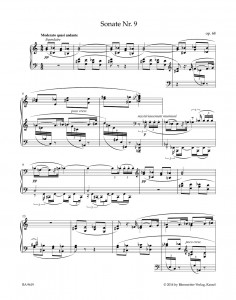Barenreiter Urtext Editions
Coinciding with the centenary year Barenreiter have produced exceptional new editions of the sonatas (volumes I, II & IV currently published with volume III in preparation). These Urtext editions reflect the latest scholarship, taking previously unknown sources into account, and include:
– All fragmentary works, some published for the first time
– Extensive foreword (Ger/Eng) and critical commentary (Eng) from Scriabin scholar, Christoph Flamm
Christoph Flamm has written for the Scriabin Association:
This new critical edition of Scriabin’s piano sonatas pursues a variety of objectives.
Firstly it is taking the title “complete piano sonatas” literally: for the first time, this edition is combining the 10 numbered sonatas with the unnumbered youthful sonatas as well as with all extant sonata fragments, music which has hardly ever (and even never before) been published.
Secondly the musical text is based on a comparison of all sources available, including sketches, first drafts, and autographs which have been deemed lost until recently, such as the autographs of the sonatas nos. 5, 6, and 7. In many cases, this material is being published as well, for example some sketches for the Third Sonata or the fragmentary first draft of the Ninth Sonata.
Thirdly the critical commentary seeks not only to list the discrepancies in the sources, but to discuss the editorial choices at length whenever this seems appropriate. Already Scriabin’s contemporaries have complained about the amount of errors in Scriabin’s manuscripts, many of which have entered the corresponding first editions. Then, we know from Scriabin’s own playing conserved on piano rolls that he did not follow any notion of Urtext, changing not only details, but even structural elements of his music when performing it. Both the composer’s errors and his flexible understanding of the written musical text have to be taken in mind when judging about variant readings in the sources.
Finally it is the editor’s conviction that a real understanding of Scriabin’s sonatas is possible only when being informed about the background of the music: the historical place of the sonatas, the composer’s biographical situation and aesthetical profile in the respective periods of composition, the composer’s programmatic ideas as discernible not only in the verbal elements of the scores, but in his letters and philosophical writings as well as in reminiscences of his contemporaries. It is for this reason that the prefaces to the editions are of exceptional length, not only covering genesis, source tradition and editorial principles, but giving in-depth information about the formal and semantical layers of the music, ultimately leading to a hermeneutical understanding of the sonatas as an artistic whole.
Further reading
Nils Franke has published an extensive interview with the editor of the new Bärenreiter Scriabin sonata edition in Piano Journal, Issue 95 (Winter 2011), pp. 30-32. A history of the attempts and problems of Scriabin philology, in German language, can be found in: Christoph Flamm, ‘“Die Notation […] deutet immer nur an.” Philologische Bemerkungen zu Skrjabin’, Alexander Skrjabin zum 100. Todestag, ed. by Christoph Flamm, Laaber: Laaber-Verlag 2015 (= MusikTheorie. Zeitschrift für Musikwissenschaft 30, 2015, no. 2), pp.171–186.
Christoph Flamm
Samples of the clear text are below and more information click on the samples or to purchase visit here.





